Archive for February, 2017
Defying Boundaries: exhibition ‘Across Japan’ at Modemuseum Hasselt
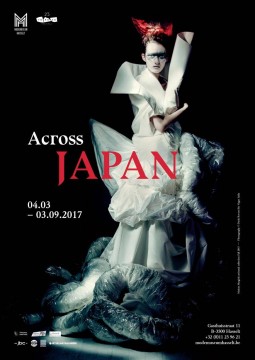
The encounter between East and West is usually that of two traditions whose boundaries are clearly set. The exhibition Across Japan, at Modemuseum Hasselt from March 3rd 2016, is a fascinating way to show how these boundaries, sharply defined only in appearance, are indeed blurred.
The exhibition explores the influences Japan in general, its materials, techniques and images, and also Japanese designers have had on the western – and global – fashion system. This due to a history of connections and relationships, commercial as much as aesthetic and technological, but also due to the fascination Japanese culture has had on western culture. Focusing on imagery, lines, inspirations but also actual interventions Japanese designers have made into the west, as the wave of designers who relocated in Paris in the 1970s and 1980s, the exhibition deploys as a chronological exploration that individuates five themes: Japonism, Wabi Sabi, Ma, Gi-jutsu and Kawaii. the first section gives the historical context, explaining the trade that linked Japan to the West in the second half of nineteenth century, through the Great Exhibitions till the influence kimonos had on the straight lines of designs by Vionnet and Balenciaga, among others; Wabi Sabi refers to the Japanese concept of beauty as ‘imperfect, incomplete, impermanent’, embraced by designers such as Martin Margiela; Ma deals with the relationship between the body and dress; Gi-Jutsu explores materials and techniques, and their crossovers in the work of both western and Japanese designers; finally Kawaii is presented in its influence on contemporary designs, which bear cute and erotic meanings altogether.

Issey Miyake and Tim Hawkinson, pleated dress in ecru with grey print. Pleats, please. Guest Artist Series No. 3,1998. Fashion Museum Hasselt. Photo: Kristof Vrancken © Fashion Museum Hasselt/Kristof Vrancken
The exhibition features designs from Balenciaga, Thom Browne, Comme des Garçons, Delpozo, Ann Demeulemeester, Rudi Gernreich, Givenchy, Iris van Herpen, Yoshiki Hishinuma, Maison Margiela, Niels Peeraer, Alexander McQueen, Issey Miyake, Hanae Mori, Dries Van Noten, Paul Poiret, Raf Simons, Kenzo Takada, Undercover, Viktor & Rolf, Junya Watanabe, Vivienne Westwood, Bernhard Willhelm, Kansai Yamamoto, and Yohji Yamamoto.
Check out Modemuseum Hasselt Website to know more – and don’t miss the opportunity to go Across Japan by visiting the exhibition
Fashion and Design – Technology
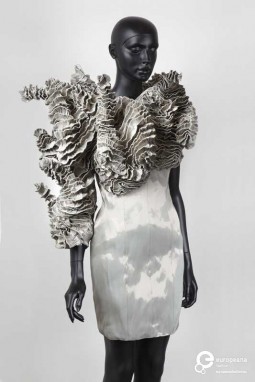
Fashion and design share a common language, owing much to each other progress. Although their products are usually different – in terms of use, material and destination – they ways the one influences the other are many and disparate. Technology, in particular, serves as an instrument for both design and fashion; the improvements each field makes turn out to be new instruments in the hands of the other.

Dress, Gianni Versace, ca. 1990; Vermelha Chair, Fernando Campana and Humberto Campana, 1993. Photo by Alberto Mayer, all rights reserved.
As it is clear in the pictures that compose MUDE – Museu do Design e da Moda curation of Europeana Fashion Tumblr, the boundaries among art, design and fashion are not strict. They are instead extremely blurred whether is the value and role we recognize to each of these practices, as these mainly work and proceed tightly connected one to each other, referencing each of the other disciplines and exploring common thematises.
It is not surprising therefore that there are designers – in fashion and design – who not only cross the boundaries experimenting both in one and on the other field, but whose work focuses on lingering on this blurred boundary. However, these designers are not the only one that delve with this theme in their work.
In fact, common to the practice of design and fashion is new technologies, in its wider sense. Designers draw both from its past and its ultimate innovations, adapting them to their best use, could this be producing a lace or building door handle. Laser-cutting, cast moulding and 3D printing, for instance, are some of the practices that in recent times are borrowed by the practices of design and fashion.
Sharing technology, they also share the issues relate to it and their aims, sometimes, overlap. Reproducibility, democratisation and, more crucially, sustainability are issues that fashion and design are called to face. And while they seem to proceed parallel to each other, the ideas they develop and the problems they step into, both contribute to their research for new – and fashionable – solutions.
Runway Archive: Helmut Lang, A/W 1989-90
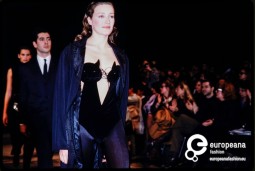
The picture captures the final moment of the a/w 1989-90 fashion show by Helmut Lang. On the foreground, a model sports one of the designer’s most evocative creations, a bodysuit shaped as the silhouettes of two black cats, whose whiskers ties to make it tighter.
The Viennese designer Helmut Lang is acclaimed as one of the ultimate fashion innovator and, although he left fashion in 2005 to pursue a career in visual arts, his original designs are sought after by archivists and stylists. He is still a reference for contemporary fashion designers, as his work still resonates in fashion today, even in the ways fashion is presented. In 1989, he rejected the traditional structure of the fashion show and introduced his ‘Séance de Travail’, working sessions in which he presented his latest designs, both for womenswear and menswear. When he moved his studio across the ocean to New York in 1998, he also presented his a/w 1998-99 collection on the Internet, and the following season he moved his s/s 1999 show ahead of the European schedule, eventually shifting the fashion calendar.
Exhibition Archaeology: ‘Stretching Boundaries, Fashion and Beyond’
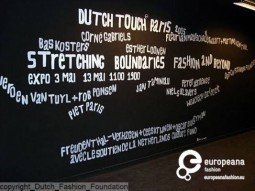
One of the most interesting features of fashion is its geographical specificity, which leads to the privileged ability fashion has to gather and represent national identities. In 2005, the exhibition Stretching Boundaries, Fashion and Beyond presented in Paris and New York, had exactly this aim: showcase the peculiarities and characters of the contemporary Dutch fashions scene.

Stretching Boundaries. Fashion and Beyond at Gallery Passage du Désir, Paris, May 2005, Photo Courtesy ModeMuseum Provincie Antwerpen, All Rights Reserved
Opened on 3rd May 2005 at the gallery Passage du Désir, and repurposed in New York the following September at the Diane Von Furstenberg Gallery, the exhibition was curated by Angelique Westerhof; it featured the work of an array of different professionals:Bas Kosters, Cees Krijnen, Corné Gabriels, Esther Loonen, Fleur van Maarschalkerwaart, Freudenthal Verhagen, Jan Taminiau, Jeroen van Tuyl, Martine van ‘t Hul, Niels Klavers, Oscar Suleyman, Peter Jeroense, Piet Paris, Rob Ponsen, Wojtek Dziedzic. Each of them with a specific aesthetic, their inner diversity really stretched the boundaries on the very definition of dutch fashion, reflecting on its various forms and key features.
The exhibition took the form of a path in which video installations, paintings, 3D art projects, graphic interventions were organised in order to represent, in an heterogeneous but coherent way, the very meaning of contemporary dutch fashion, from the view of its makers. Fashion is both the subject and the object of this experimental exploration, and each designer was asked to produce something that could speak of their own take on dress, most of the times going beyond the boundaries of fashion itself.
The decision to install the exhibition first in paris and then in New York was another way of crossing the boundaries, this time geographical ones, by proposing to an international audience the national specificities of Dutch fashion. This aligned with the agenda of the organiser of the exhibition, which was one of the outputs of The Dutch Touch. The Dutch Touch is a campaign active since 2001, whose role is to showcase Dutch fashion within the international context of fairs and trade shows. It is a project of the Dutch Fashion Foundation, an organisation working on the construction and dissemination of the economic and cultural role of Dutch fashion on a national and international level. The foundation strengthens the network of Dutch fashion, gathering designers and other creatives, as artists, photographers, image makers and graphic designers.
Europeana Fashion Focus: Ensemble, Christian Dior, 1970s
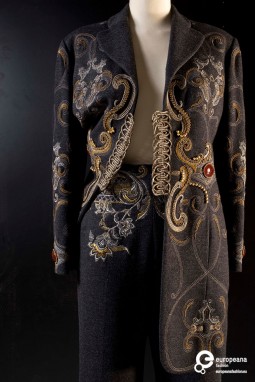

Ensemble, Christian Dior, ca. 1970, Courtesy MUDE - Museu do Design e da Moda, Colecção Francisco Capelo
The ensemble is composed by a long jacket and a pencil skirt; both items are made of grey wool and decorated with intricate embroideries in silver and golden thread. It is a creation of the Maison Christian Dior from the 1970s.
The outfit is characterised by a streamlined cut, enriched by flat decorations and tridimensional applications that make the whole ensemble a unique example of high manufacture.
The ensemble probably belongs to one of the collections produced in the 1970 by Dior, in the years in which designer Marc Bohan was at the helm of the maison. Marc Bohan was followed Yves Saint Laurent as head of the design team in 1958, and kept his position till 1989. His design aesthetic was dominated by an attention to balance and measure, both in cut and decorations, and a rejection of the excesses in favour of simplicity and elegant sobriety.
The fascination with foreign traditions was strongly felt by Bohan; the motif of the embroidery, drawing elegant lines that intertwine to create meanders, leaves and flowers, seems to recall some oriental patterns, together with the fastening of the jacket that reminds a chinese knot.
The object is part of MUDE Archive. Discover more on the Europeana fashion portal.
Runway Archive: Giorgio Armani, Pitti Uomo 15, 1979
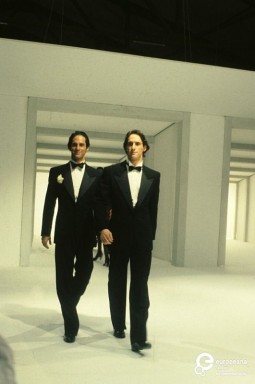
The picture shows two elegant looks styled by two male models; the models are wearing two similar tuxedos – or dinner suits – composed by loose trousers, long jackets with wide lapels, white shirts; the looks are completed by papillons, and one of them shows a boutonnière on the right side of the jacket. The two outfits belong to Giorgio Armani’s 1979 collection, shown in Florence in occasion of Pitti Immagine 15.
Florence has been one of the Italian capitals of fashion at least since 1951, when the first collective fashion show was organised by Giovanni Battista Giorgini and held in the Sala Bianca. in 1954 was founded the Centro di Firenze per la Moda Italiana (CFMI) to promote Italian fashion, but it was only from the 1970s that Palazzo Pitti became the stage for showcasing the many aspects of Italian fashion to international markets. Pitti Uomo was founded in 1972, with the precise intent of promoting clothing and accessories for men. It was in this context that Giorgio Armani showed his first collections, using the catwalk to communicate his idea of menswear, and preceding what he would later do in Milan with his womenswear collections.
The Toile. Between finished and unfinished
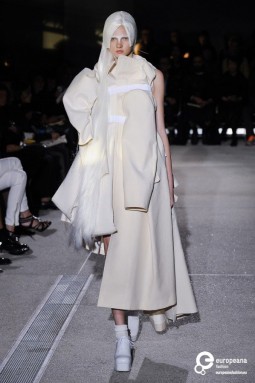
Conventions in dress are sometimes boundaries that cannot be easily crossed. This is valid for fabrics as well, whose material qualities sometimes limit their use for one or another occasion; while some fabrics command their use in some proper settings, one in particular, the toile, even rules over the definition of product and prototype.

Prototype of an ensemble designed by Frank Govers. Courtesy Gemeentemuseum den Haag, all rights reserved.
Plain-weave and unbleached, the toile consists of a linen or cotton muslin, and comes in different weights. Generally inexpensive, in ateliers the toile is the fabric used to create prototypes and mock-ups, its plain qualities enabling experimentation both in draping and tailoring.
Its use is so popular that the name toile – although coming from French and meaning cloth or canvas – has been extended to indicate the mock-up or prototype of the final creation, usually made with this fabric. It has been in use since the nineteenth century and even though it implicates a further passage in the design line, it is essential to assure the final product a perfect fit or for the fabric to drape in the best way.
Toile – the fabric – is for convention bounded to the atelier, its use limited to produce the mock-ups and generally disregarded for the creation of actual garments and accessories; even though, even though it is durable and resistant.

Comme des Garçons, s/s 2013 fashion show. Photo Etienne Tordoir, courtesy Catwalkpictures, all rights reserved.
Some designers, however, have overturned this norm, showing the fascinating aspects and details of prototyping and of its materials, lingering on the subtle edge between finished and unfinished. Martin Margiela in particular delved with this theme in his ‘Semi Couture’, s/s 1997 and a/w 1998-99 collections, with coats made out of pattern-paper or vests resembling the bodice of atelier’s dummies; John Galliano showed for Dior a/w 2004-05 couture collection, an ‘unfinished’ couture gown, exposing nude silk and paddings, baring the ingenuous act of draping and designing, making something spectacular of the ‘demure’ material; more recently Rei Kawakubo sent out on the catwalk of Comme des Garçons s/s 2013 fashion show elaborate silhouettes in canvas and twill, showing how experimentations of this kind are able to push the boundaries of established fashion conventions.
On Pink, Blue and other Myths: Divided by Colours
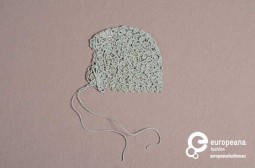
Colour, in clothing and accessories, is one if not the most straightforward element speaking of the wearer. Not only it is significant of tastes and personal preferences, but it can easily become charged with cultural relevance, when used in a precise historical and geographical context.
Fashion can indeed set the boundaries of identity though colours. Historically, some colours were reserved to some strata of society, being used as disclaimer to associate a person to a particular class; this is the case of gold, whose use was restrained by sumptuary laws in the early modern period, given its ideal link to wealth and high status; same can be said of purple, which in the Tudor period in England was especially reserved to kings, queens and some members of the aristocracy. Colours are charged of different meanings – some times, almost opposites – in different cultures: for instance, while black is accounted as the colour of mourning in Europe since the Roman Empire, in Asia the colour used by people participating in mourning is white.
Sometimes the meaning of colours can shift through times, originating tropes and myths that are hard to die out, even though there are no apparent reasons for their existence. Maybe the most widespread of the ‘myths’ surrounding colours is the binary that wants pink associated with girls and blue with boys. While white was the most practical and neutral colour of children clothing during the nineteenth century, it was at the beginning of twentieth century that pastel colours for babies were introduced. Museums and archives that feature children clothing from the late nineteenth and early twentieth centuries in their collections are useful to challenge the trope that associates colours to genders. In fact, interestingly enough, in 1918 an account on the american newspaper Ladies’ Home Journal stated that ‘The generally accepted rule is pink for the boys, and blue for the girls. The reason is that pink, being a more decided and stronger color, is more suitable for the boy, while blue, which is more delicate and dainty, is prettier for the girl.’ this demonstrates that the ’trope’ as we know it today – pink for girls and blue for boys – is quite recent: it started being used and marketed during the 1940s. It got periodically reinforced ever since, setting a ‘contemporary’ boundary that is now heavily criticised: a sign of a changing sensibility within society, that might change again the perception future generations will have of these colours – and of their power to create categories.
Runway Archive: Isaac Mizrahi, A/W 1997-1998

Isaac Mizrahi, Autumn-Winter 1997-1998, Photo by Etienne Tordoir, Courtesy Catwalk Pictures, All Rights Reserved
The look shown in the picture is composed by a long, sleeveless dress gently flowing on the body of the model, and completed by white sandals. The dress is made of two layers: a basis in sheer, pale pink fabric and a net of shimmering material. The outfit belongs to Isaac Mizrahi’s Autumn-Winter 1997-1998 Womenswear collection, shown in New York.
Isaac Mizrahi is an American fashion designer trained at Parsons School of Design. He comes from a Syrian Jewish family, and it was his family to favour his entering into the fashion world: at the age of 15, he received a sewing machine from his father. He started his eponymous label in 1987 in New York, where the collection was presented in a trunk show held by Bergdoorf Goodman. Apart for his feminine and refined designs, chosen by many celebrities for public events, Mizrahi is also known for his interest in media and performance: he took part to several TV programmes throughout the 1990s and 2000s, and collaborated with many institution as costume designer. The making of his 1994 collection was turned into a documentary, called ‘unzipped’.
From (Selv)edge to (Selv)edge
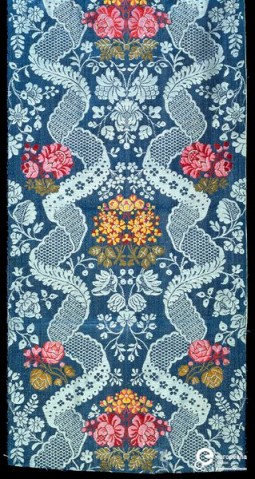
Fabric is essential to fashion, whether its shape or dimension, it often delimits the material area in which designers and tailors can experiment to resolve their ideas. In this way, the boundaries of fabric are translated into the boundaries of fashion itself, whose definition is then from selvedge to selvedge.

Checkered fabric in linen, 1950-1970. Courtesy MoMu - ModeMuseum Provincie Antwerpen, all rights reserved.
While the length of a fabric can virtually be extended to the wish of its producer, its width is subdued to the width of the loom used to produce it. Although the world’s widest loom ever made – created by Jürgens GmbH & Co. of Emsdetten in May 2005 – measures 33,15 m (108.75 ft), the usual width of fabrics revolves around 0,70 and 3 meters.
Selvedge is the name used to indicate its extremes. selvedges run parallel to warp of the fabric and are usually created by the looping back of the weft thread with the main function to prevent the fabric to fray or unravel, finishing the fabric as it exits from the loom. To do this, the weft threads turn and go back on themselves while they are whirled around the warp. Since they are created along with the fabric, their style and size depends on the way the fabric is produced and on the type of loom involved.

Dress fabric of glazed brocaded worsted, probably made in Norwich, 1760-1770. Courtesy Victoria and Albert Museum, CC BY.
Stiff and sound, they can come plain or similar to the rest of the fabric, but otherwise they can be customised using thread in fancy colours. Sometimes instead, when jacquard looms or prints are involved, it is use to write on the selvedge the information of the fabric, as its commercial name, composition, or the name of its producer.

Dress designed by Dries van Noten, s/s 2010. Photo Stephen Matteus for MoMu. Courtesy MoMu - ModeMuseum Provincie Antwerpen, all rights reserved.
Being stiffer and differing the texture of the rest of the fabric, they are usually discarded. Sometimes however, because of their peculiarities, they are used in design as embellishment or as structural resolutions. As they are made to prevent the fabric to fray, they don’t need any finishing, and their colours variations are intelligently used in other designs as hems decorations. Indeed, even if they limit the fabric, they don’t limit creativity.









